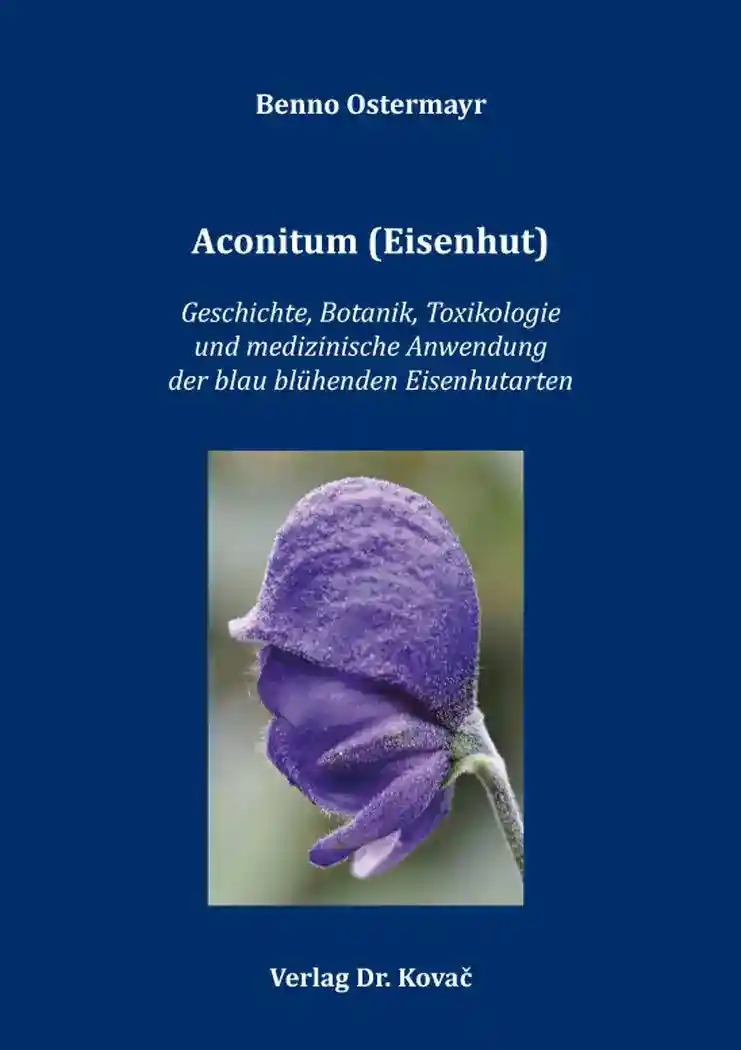Benno OstermayrAconitum (Eisenhut)
Geschichte, Botanik, Toxikologie und medizinische Anwendung der blau blühenden Eisenhutarten
Hardcover
HIPPOKRATES – Schriftenreihe Medizinische Forschungsergebnisse, volume 104
Hamburg 2022, 546 pages
ISBN 978-3-339-13214-7 (print) |ISBN 978-3-339-13215-4 (eBook)
Rezension
[...] Inhaltlich und sprachlich klar gegliedert gibt dieses Buch eine detaillierte und umfangreiche Übersicht zu den unterschiedlichen Einsatzgebieten des Eisenhuts im Laufe der Zeit. Somit kann dieses Werk uneingeschränkt nicht nur wissenschaftlich tätigen Personen, sondern auch botanisch und pharmazeutisch Interessierten empfohlen werden.
About this book deutschenglish
Aconitum (Monkshood) – Poison and Remedy
History, botany, toxicology and medicinal uses of the blue-coloured Aconitum species
The blue-coloured monkshood plants have always attracted the attention of naturalists, physicians and writers because of their majestic appearance, but also because of their extreme toxicity. In the present monograph the history and the botanical, pharmacological and toxicological aspects of medicinally important aconite species (Aconitum napellus, ferox, carmichaelii etc.) are summarized and described.
Aconitum napellus and related species contain highly toxic alkaloids, like aconitine, which even in small milligram doses can cause life-threatening effects in humans and animals. Due to their toxicity, extracts of aconite were used in the past not only as hunting and arrow poisons, but also for homicidal purposes; a number of spectacular poisonings, such as the fatal attempt on the life of the Roman emperor Claudius, are associated with these plants.
Accidental and medicinal poisoning with monkshood continue to occur until the present day. As relevant literature demonstrates, knowledge of the characteristic poisoning symptoms and rapid initiation of appropriate treatment can be of vital importance for the affected person.
Plant poisons exhibit a remarkable pharmacological potential with great utility; Aconitum has therefore been used as a remedy since ancient times in both western and eastern medicine. At the end of the 17th century, the plant found its way into the European medical schools, and after the pathogenetic trials conducted by Hahnemann and subsequent authors, Aconitum napellus was frequently used in homeopathy as an “acute remedy” for the treatment of infections, fever, nerve pain, anxiety disorders etc.
In traditional Chinese and Ayurvedic medicine, aconite preparations such as Fuzi and Vatsanabha are part of classical prescriptions, which are still frequently used, especially for chronic diseases (diabetes, rheumatism, kidney- and cardiovascular diseases etc.). The latest results of research studies indicate that the traditional health claims for these medicinal drugs have a scientific basis.
Keywords
AconitinAconitumAlkaloideAyurvedaBotanikClaudiusEisenhutEisenhuthummelEisenhutvergiftungErkältungFieberFuziHahnemannHomöopathieLamsonMedizinPfeilgiftPflanzengiftRanunculaceaeSchockStoerckTCMTherapieToxikologieVatsanabhaVergiftungVergiftungssymptomeIhr Werk im Verlag Dr. Kovač

Möchten Sie Ihre wissenschaftliche Arbeit publizieren? Erfahren Sie mehr über unsere günstigen Konditionen und unseren Service für Autorinnen und Autoren.
